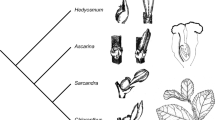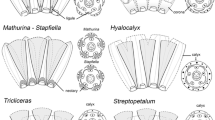Abstract
New investigations on the flower and fruit structure of extantHamamelidaceae and other LowerHamamelididae together with new finds of fossil flowers and seeds from the Upper and Lower Cretaceous provide the outline of an increasingly more differentiated picture of the early evolution of the subclass. Three patterns of valvate anther dehiscence are recognized in the subfamilyHamamelidoideae (and the subclassHamamelididae). The basic (plesiomorphic) type within theHamamelididae has 2 valves per theca. The type with 1 valve but 2 pollen sacs per theca is both consistent and exclusive for the 5 southern genera of theHamamelidaceae. They seem to be the remnants of a homogeneous group that originated before the Upper Cretaceous. This is supported by fossil hamamelidaceous flowers from the Upper Cretaceous that have thecae with 1 valve. Since several-seededHamamelidaceae predate one-seeded forms in the fossil seed record (in Europe) and the systematic structure of the one-seeded group is relatively more homogeneous, several-seeded groups are considered to be more ancient. Several parallel evolutionary trends are recognized within theHamamelidaceae as well as within the LowerHamamelididae: anther dehiscence with 2 valves per theca → 1 slit or 1 valve; pollen sacs per theca 2 → 1; pollen tricolpate → polyforate; exine coarsely reticulate → finely reticulate; loss of perianth (tepals or petals and sepals) and concomitant loss of fixed number of floral organs; differentiation of exposed nectaries.
Similar content being viewed by others
References
Baillon, H., 1894: Les ovules desCorylopsis. — Bull. Soc. Linn. Paris2 (142): 1122–1123.
Bogle, A. L., 1970: Floral morphology and vascular anatomy of theHamamelidaceae: The apetalous genera ofHamamelidoideae. — J. Arnold Arbor.51: 310–366.
—, 1984: Floral morphology and vascular anatomy ofMaingaya Oliv. (Hamamelidaceae, Hamamelidoideae, Hamamelideae). — Amer. J. Bot.71 (5, 2): 19.
—, 1986: The floral morphology and vascular anatomy of theHamamelidaceae: subfamilyLiquidambaroideae. — Ann. Missouri Bot. Gard.73: 325–347.
—, 1980: A generic atlas of hamamelidaceous pollens. — Contr. Gray Herb.210: 29–103.
Budantsjev, L. J., 1975: Morphology of the leaves and taxonomy of the generaProtophyllum Lesq. andPseudoprotophyllum Hollick. — InBudantsjev, L. J., (Ed.): Problems of comparative morphology of the seed plants, pp. 90–107. — Leningrad: Nauka (in Russian).
Burgh, J. van der, 1983: Allochthonous seed and fruit floras from the Pliocene of the Lower Rhine basin. — Rev. Palaeobot. Palynol.40: 33–90.
Chang, H. T., 1973: A revision of the hamamelidaceous flora of China. — Sunyatsen Univ. Bull.1: 54–71 (in Chinese).
Chang, K.-T., 1979: The spore and pollen morphology in relation to the taxonomy and phylogeny of some plant groups. — Acta Phytotax. Sin.17 (2): 1–8 (in Chinese).
Collinson, M. E., 1982: A preliminary report on the Senckenberg-Museum collection of fruits and seeds from Messel bei Darmstadt. — Cour. Forsch.-Inst. Senckenberg56: 49–57.
—, 1983: Fossil plants of the London Clay. — London: The Palaeontological Association.
—, 1984: Early TertiaryHamamelidae: a contribution from isolated fossil organs. — Amer. J. Bot.71 (5, 2): 109.
Crane, P. R., 1989: Paleobotanical evidence on the early radiation of nonmagnoliid dicotyledons. — Pl. Syst. Evol.162: 165–191.
—, 1986: Morphology and development of pistillate inflorescences in extant and fossilCercidiphyllaceae. — Ann. Missouri Bot. Gard.73: 382–393.
—, 1986: Lower Cretaceous angiosperm flowers: fossil evidence on early radiation of dicotyledons. — Science232: 852–854.
Cronquist, A., 1981: An integrated system of classification of flowering plants. — New York: Columbia University Press.
Docters van Leeuwen, W. M., 1927: Vogelbloemen. 3.Rhodoleia Teysmanni Miq. — Trop. Natuur16: 2–6.
—, 1938: Observations about the biology of tropical flowers. — Ann. Jard. Bot. Buitenzorg48: 27–68.
Ehrendorfer, F., 1977: New ideas about the early differentiation of angiosperms. — Pl. Syst. Evol. Suppl.1: 227–234.
Eichholz, G., 1886: Untersuchungen über den Mechanismus einiger zur Verbreitung von Samen und Früchten dienender Bewegungserscheinungen. — Jahrb. Wiss. Bot.17: 543–590.
Endress, P. K., 1967: Systematische Studie über die verwandtschaftlichen Beziehungen zwischen den Hamamelidaceen und Betulaceen. — Bot. Jahrb. Syst.87: 431–525.
Endress, P. K., 1970: Die Infloreszenzen der apetalen Hamamelidaceen, ihre grundsätzliche morphologische und systematische Bedeutung. — Bot. Jahrb. Syst.90: 1–54.
—, 1977: Evolutionary trends in theHamamelidales-Fagales-group. — Pl. Syst. Evol. Suppl.1: 321–347.
—, 1978: Blütenontogenese, Blütenabgrenzung und systematische Stellung der perianthlosenHamamelidoideae. — Bot. Jahrb. Syst.100: 249–317.
—, 1986: Floral structure, systematics, and phylogeny inTrochodendrales. — Ann. Missouri Bot. Gard.73: 297–324.
—, 1987: Floral phyllotaxis and floral evolution. — Bot. Jahrb. Syst.108: 417–438.
—, 1985:Noahdendron, a new Australian genus of theHamamelidaceae. — Bot. Jahrb. Syst.107: 369–378.
Flint, F. F., 1959: Development of the megagametophyte inLiquidambar styraciflua L. — Madroño15: 25–29.
Friis, E. M., 1984: Organisation og bestøvningsformer hos blomster fra Øvre Kridt. — Dansk Geol. Foren, Årsskr.1983: 1–8.
—, 1985a: Angiosperm fruits and seeds from the Middle Miocene of Jutland (Denmark). — Biol. Skr.24 (3): 1–165.
—, 1985b: Structure and function in Late Cretaceous angiosperm flowers. — Biol. Skr.25: 1–37.
Gregor, H.-J., 1975: Die mittelmiozäne Mastixioideen-Flora aus dem Braunkohlen-Tagebau Oder II bei Wackersdorf (Oberpfalz). — Diss., Univ. München.
—, 1977: Subtropische Elemente im europäischen Tertiär (Fruktifikationen). — Paläont. Z.51: 199–226.
—, 1978: Die miozänen Frucht- und Samen-Floren der Oberpfälzer Braunkohle. 1. Funde aus den sandigen Zwischenmitteln. — Palaeontographica, Abt. B,167: 8–103.
—, 1982: Die jungtertiären Floren Süddeutschlands. — Stuttgart: Enke.
—, 1986: Zur Flora des Randecker Maares (Miozän, Baden-Württemberg). — Stuttgarter Beitr. Naturk., Ser. B,122: 1–29.
Harms, H., 1930:Hamamelidaceae. — InEngler, A., Prantl, K., (Eds.): Die natürlichen Pflanzenfamilien18 a, pp. 303–345, 487, 2 ed. — Leipzig: Engelmann.
Herman, A. B., 1984: A new genus of platan-tree-like angiosperms. — Paleont. Ž.1984 (1): 71–79.
Hesse, M., 1978: Entwicklungsgeschichte und Ultrastruktur von Pollenkitt und Exine bei nahe verwandten entomophilen und anemophilen Angiospermensippen:Ranunculaceae, Hamamelidaceae, Platanaceae undFagaceae. — Pl. Syst. Evol.130: 13–42.
Jäger-Zürn, I., 1966: Infloreszenz- und blütenmorphologische sowie embryologische Untersuchungen anMyrothamnus Welw. — Beitr. Biol. Pfl.42: 241–271.
Kaul, U., Kapil, R. N., 1975:Exbucklandia populnea—from flower to fruit. — Phytomorphol.24: 217–228.
Knappe, H., Rüffle, L., 1975: Beiträge zu den Platanaceen-Funden und einigenHamamelidales der Oberkreide. — Wiss. Z. Humboldt-Univ. Berlin, math.-nat. R.,24: 487–492.
Knobloch, E., Mai, D. H., 1984: Neue Gattungen nach Früchten und Samen aus dem Cenoman bis Maastricht (Kreide) von Mitteleuropa. — Feddes Repert.95: 3–41.
—, 1986: Monographie der Früchte und Samen in der Kreide von Mitteleuropa. — Rozpravy Ústř. Úst. Geol. Praha47: 1–219.
Kugler, H., 1956: Über die optische Wirkung von Fliegenblumen auf Fliegen. — Ber. Deutsch. Bot. Ges.69: 387–398.
Mai, D. H., 1968: Zwei ausgestorbene Gattungen im Tertiär Europas und ihre florengeschichtliche Bedeutung. — Palaeontographica, Abt. B,123: 184–199.
—, 1978: Die Floren der Haselbacher Serie im Weisselster-Becken (Bezirk Leipzig, DDR). — Abh. Staatl. Mus. Mineral. Geol. Dresden28: 1–200.
Mai, D. H., Walther, H., 1985: Die obereozänen Floren des Weisselster-Beckens und seiner Randgebiete. — Abh. Staatl. Mus. Mineral. Geol. Dresden33: 5–176.
Manchester, S. R., 1986: Vegetative and reproductive morphology of an extinct plane tree (Platanaceae) from the Eocene of Western North America. — Bot. Gaz.147: 200–226.
Mizushima, M., 1968: On the flower ofDisanthus cercidifolius Maxim. — J. Japan. Bot.43: 522–524 (in Japanese).
Morley, B., Chao, J.-M., 1977: A review ofCorylopsis (Hamamelidaceae). — J. Arnold Arbor.58: 382–415.
Nast, Ch. G., Bailey, I. W., 1945: Morphology and relationships ofTrochodendron andTetracentron. II. Inflorescence, flower, and fruit. — J. Arnold Arbor.26: 267–276.
Petit-Thouars, A. A. Du, 1805: Histoire des végétaux recueillis dans l'isles australes d'Afrique. 1. — Paris: Levrault, Schoell.
Praglowski, J., 1974: The pollen morphology of theTrochodendraceae, Tetracentraceae, Cercidiphyllaceae, andEupteleaceae, with reference to taxonomy. — Pollen & Spores16: 449–467.
Rüffle, L., 1968: Merkmalskomplexe bei älteren Angiospermen-Blättern und die Kutikula vonCredneria Zenker (Menispermaceae). — Palaeontographica, Abt. B,123: 132–143.
Schoenland, S., 1883: Über die Entwicklung der Blüten und Frucht bei den Platanen. — Bot. Jahrb. Syst.4: 308–327.
Skvortsova, N. T., 1975: Comparative morphological studies on representatives of the familyHamamelidaceae and their phylogenetic relationships. — InBudantsjev, L. J., (Ed.): Problems of comparative morphology of the seed plants, pp. 7–24. — Leningrad: Nauka (in Russian).
Smith, A. C., 1945: A taxonomic review ofTrochodendron andTetracentron. — J. Arnold Arbor.26: 123–142.
Smith, L. S., 1958: New species of and notes on Queensland plants 3. — Proc. Roy. Soc. Queensland69: 43–51.
Steven, D. De, 1983: Floral ecology of witch-hazel (Hamamelis virginiana). — Michigan Bot.22: 163–171.
Takhtajan, A. L., 1969: Flowering plants. Origin and dispersal. — Edinburgh: Oliver & Boyd.
—, (Ed.) 1974: Fossil flowering plants of the USSR. 1.Magnoliaceae—Eucommiaceae. — Leningrad: Nauka (in Russian).
Tao, J.-R., Xiong, X.-Z., 1986: The latest Late Cretaceous flora of Heilongjiang Province and the floristic relationship between East Asia and North America. — Acta Phytotax. Sin.24: 1–15, 121–135.
Tiffney, B. H., 1986: Fruit and seed dispersal and the evolution of theHamamelidae. — Ann. Missouri Bot. Gard.73: 394–416.
Upchurch, G. R. Jr., 1985: Cuticle evolution in early Cretaceous angiosperms from the Potomac Group of Virginia and Maryland. — Ann. Missouri Bot. Gard.71: 522–550.
Vaudois-Miéja, N., 1979: Sur un fruit fossile d'Hamamélidacées dans les Grès à Sabals de l'ouest de la France. — C. R. Congr. Nat. Soc. Sav., I,104: 263–273.
Vink, W., 1957:Hamamelidaceae. — InSteenis, C. G. G. J. van, (Ed.): Flora Malesiana, Ser. I,5, pp. 363–379. — Dordrecht: Nijhoff.
Wisniewski, M., Bogle, A. L., 1982: The ontogeny of the inflorescence and flower ofLiquidambar styraciflua L. (Hamamelidaceae). — Amer. J. Bot.69: 1612–1624.
Zavada, M. S., Dilcher, D. L., 1986: Comparative pollen morphology and its relationship to phylogeny of pollen in theHamamelidae. — Ann. Missouri Bot. Gard.73: 348–381.
Author information
Authors and Affiliations
Rights and permissions
About this article
Cite this article
Endress, P.K. Aspects of evolutionary differentiation of theHamamelidaceae and the LowerHamamelididae . Pl Syst Evol 162, 193–211 (1989). https://doi.org/10.1007/BF00936917
Received:
Issue Date:
DOI: https://doi.org/10.1007/BF00936917




